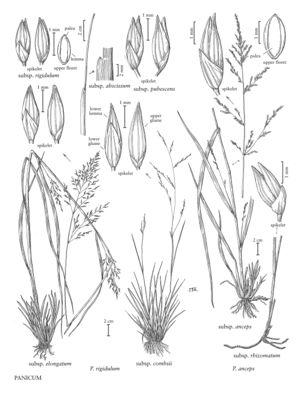Panicum rigidulum subsp. combsii
Plants similar to subsp. pubescens, but often shortly rhizomatous, more nearly glabrous, and more deeply and consistently purple throughout. Ligules nearly obsolete; blades usually 2-7 mm wide, often folded or involute, usually pilose adaxially, at least near the base, bases about equal in width to the subtending sheaths. Spikelets 2.6-3.8 mm, usually purple, slender, erect on the pedicels. Lower glumes to 3/4 as long as the spikelets.
Discussion
Panicum rigidulum subsp. combsii is restricted to the United States, where it grows in the same moist habitats as subsp. pubescens, but is much less common. Its long, narrow, purple, often gaping spikelets somewhat resem¬ble those of P. virgatum, which often grows in the same habitats.
Selected References
None.
Lower Taxa
"decumbent" is not a number."thickish" is not a number."varying" is not a number.
